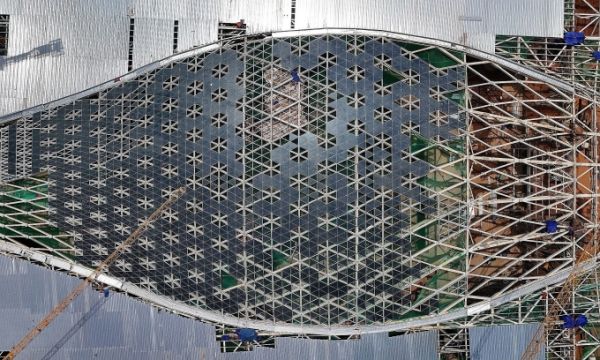
The roof of the passenger terminal of Long Thanh International Airport is under construction in Dong Nai Province, September 2025. Photo by Read/Phuoc Tuan
Ho Chi Minh City has unveiled a proposal to build a new metro and railway connection linking Tan Son Nhat and Long Thanh airports, aiming to make airport transfers faster and more convenient.
Under this plan, passengers from Tan Son Nhat Airport would transfer to Ba Queo Station on Metro Line No. 2 (Tham Luong–Ben Thanh–Thu Thiem). From there, they would switch to the Thu Thiem–Long Thanh railway to reach Long Thanh Airport.
City officials said the proposal would take advantage of Ben Thanh Station’s central role as an interchange connecting several metro lines, including Lines 1, 2, 3 and 4, which will make transfers faster and easier once the network expands. Of these, only Line No.1 is in operation, connecting Ben Thanh in HCMC center and Suoi Tien in its eastern gateway.
Metro Line No. 2 is divided into two sections: the 11-kilometer Ben Thanh–Tham Luong stretch, expected to begin construction later this year and finish before 2032; and the 6-kilometer Ben Thanh–Thu Thiem stretch, which could start sooner as it runs underground along major roads, easing land clearance challenges. The Thu Thiem–Long Thanh railway is also expected to progress quickly under similar conditions.
To boost airport connectivity, the city also plans to invest in Metro Line No. 6, which would pass through three stations near Tan Son Nhat, link up with Metro Line No. 2 at Ba Queo, continue to Thu Thiem, and then merge into the Thu Thiem–Long Thanh route leading to Long Thanh Airport.
HCMC has asked for permission to coordinate with Dong Nai Province to handle necessary procedures for the project, particularly for the Thu Thiem–Long Thanh railway. The city also plans to work with investors and contractors capable of carrying out the project under a public-private partnership (PPP) model.
Besides this proposal, three other rail connection options were reviewed, including combinations using Metro Lines 1, 2, 4 and 6 with the Thu Thiem–Long Thanh railway.
Long Thanh International Airport is slated for completion by the end of this year and is expected to begin operations in mid-2026. At present, its main connections to Ho Chi Minh City rely on key routes such as the HCMC–Long Thanh–Dau Giay Expressway, National Highway 51, National Highway 1 and Hanoi Highway.